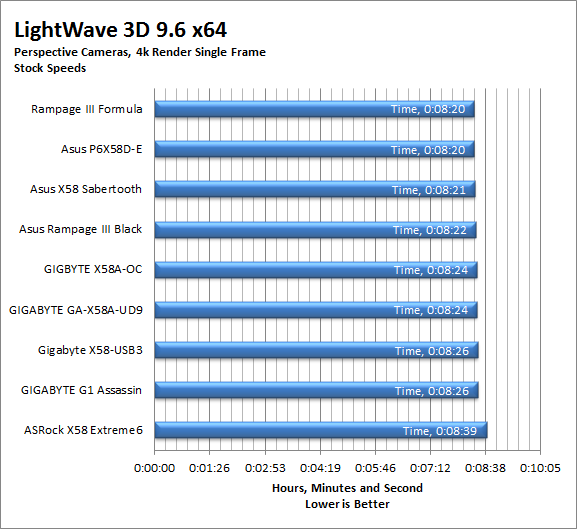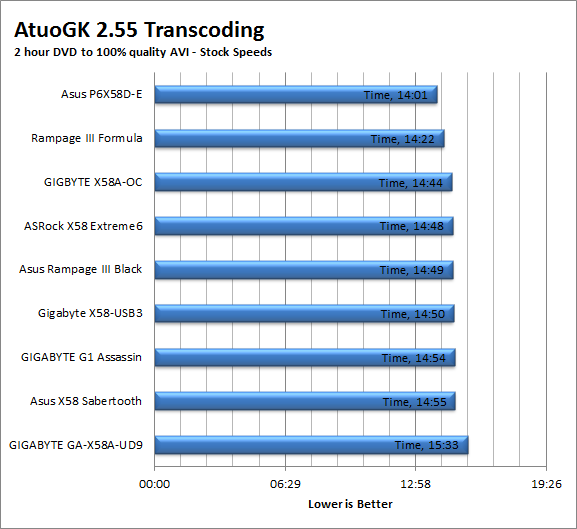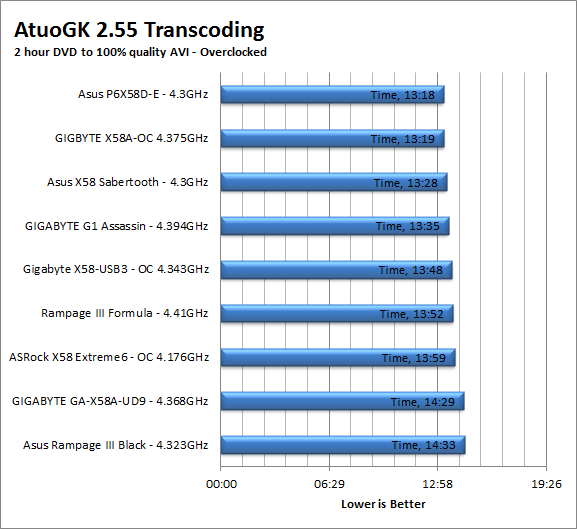Section III - Performance Tests, Real-World
Here we have two tests that are designed to put the performance of the motherboard and its subsystems to the test. Both require good CPU, Memory, HDD and even to a lesser extent audio and network performance. The two tests we chose were Lightwave 3D 9.6 and AutoGK 2.55. We will be adding at least one more real-world test to this battery in the near future, but for now these two cover quite a bit.
Lightwave 3D 9.6 x64 -
Lightwave is another industry standard application for 3D animation and rendering. It has a large tool base and the rendering engine is highly threaded (when using the right render model). This application is also capable of expanding to 4k resolutions as well as ray tracing for rending the light sources. For our testing we use frame 470 of the Pinball scene found in the LW 9 Content folder. This uses the newer perspective camera that is better suited to a multi-CPU/Core environment. This camera style also uses ray tracing and a much improved anti-aliasing method. Settings are shown below in the attached screen shot. Of course these are single frame renders and they are not a complete picture; for that you have to take into account the number of frames an average project would have. In a typical 30 second commercial you will have around 840 to 960 frames (at 28 – 32 FPS) this means that you have to multiply the time of a single frame by that number just to get a vague idea of how long that 30 seconds would take. This is because each frame will have a different render time based on complexity.
The Lightwave 3D scores we see on the RIIIB are not bad. They are within 2 seconds of the leader (Ironically enough the Rampage III Formula and the P6X58D-E) during our stock testing. This is a case of the fast HDD speeds helping to balance out the slower write times we saw on during our memory testing. When we overclocked the 980X on the board we found that we dropped in performance, again we would suspect an issue with the way the board handles memory as the actual memory speed was 1835MHz which should have given us a boost in this test. 
The project times are here to illustrate how even a 1 second difference can impact this application in real-world usage. 

AutoGK 2.55 Transcoding -
AutoGK is a transcoding software that is really multiple parts combined to make an easy to use whole. It combines, items like FDD Show, Xvid encoder, Virtual Dub and others for use in converting one media format to another (usually Xvid AVI). It will not transcode copy protected DVDs or Bluray discs yet (you still need a de-crypter for that). But it does an excellent job on everything else. For our testing we use a 2 hour movie that has been placed onto a standard definition DVD for playback; we then transcode this DVD to a 100% quality AVI with the original audio intact. This puts a strain on the CPU, Memory, HDD and the attached DVD ROM drive.
Once again our AutoGK times are affected by memory performance, but we see the HDD speed helping out a little. The real lag here was in the demuxing of the actual test DVD which is a heavy memory usage part of AutoGK’s transcoding.





